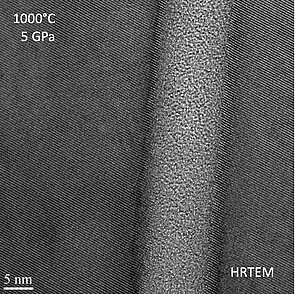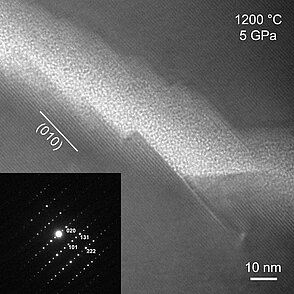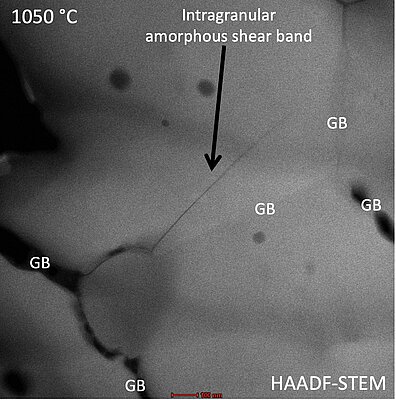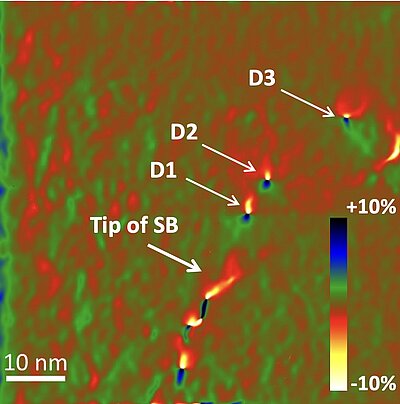On the formation mechanisms of intragranular shear bands in olivine by stress-induced amorphization
In 2021, Samae et al. described stress induced amorphization of grain boundaries in olivine promoting grain boundary sliding when temperature reaches the glass transition temperature of amorphous olivine. Here we focus, using the same material, on intragranular amorphous lamellae. These lamellae are more frequently observed in the specimens deformed at 5 GPa as shown below.
We found however some occurrence also in the specimens deformed in the Paterson apparatus. Of particular interest among those is the lamella shown below which nucleates at an amorphous grain boundary and arrests inside a grain. This particular configuration represents a frozen state of a lamella propagating in the grain and offers the possibility of understanding the amorphization mechanism.
Since this lamella is very thin, it could be investigated at high resolution. It does not propagate in a specific plane and we find that it involves a complex and heterogeneous displacement field which reminds of the modes I, II and III of shear as classified in brittle failure. The role of shear underlined in Idrissi et al. (2022a) is here confirmed. The detailed analysis of the strain fields ahead of the tip shows the presence of dislocations and of some rotational defects tentatively interpreted as disclinations.
As reviewed in Idrissi et al. (2022a), there are currently two models to account for stress-induced amorphization. One considers amorphization as the latest stage of deformation (high strain) when a crystal is saturated of defects. The resulting increase of internal energy leads to the instability and to amorphization. The other model represents the opposite situation when, for some reason (low temperature, high strain-rate), the usual mechanisms of ductile deformation are inhibited. The stress can then reach the ultimate limit of mechanical stability.
Our observations favor the last model. In grain which exhibit evidence for dislocation activity, our observation show no clear correlation between the dislocation microstructure and amorphous lamellae (see Figure 1c). We do see evidence for dislocations nucleated ahead of the tip of the lamella, but the density is too low to trigger amorphization. We find however that these dislocations dictate the path of the propagating lamella. The orientation of the Burgers vectors show that those dislocations are not emitted by the Lamella. Instead we interpret them as dislocations nucleated ex nihilo. We have also observed some rotational defects that we tentatively interpret as disclinations. All these evidence suggest that the stress ahead of the lamella is so high that mechanical instability is reached, amorphization being a response to that situation.

All these observations support our interpretation of amorphization as a response to very strong stresses, close to the theoretical limit of the crystal. In such a situation, the weak zones are the first to be affected, first of all the grain boundaries as described in Samae et al. (2021). One can also note some planes whose ultimate strength is lower like the (010) plane (see the figure on the top left). This has been shown by the theoretical calculations of Gouriet et al. (2019). In the case where such weak zones are not available, the formation of amorphous lamellae occurs in response to the local stress field as observed here.
To learn more:
H. Idrissi, A. Béché, N. Gauquelin, I. Ul Haq, C. Bollinger, S. Demouchy, J. Verbeeck, T. Pardoen, D. Schryvers & P. Cordier (2022b) On the formation mechanisms of intragranular shear bands in olivine by stress-induced amorphization. Acta Materialia, 239, 118247, https://doi.org/10.1016/j.actamat.2022.118247
References:
- K. Gouriet, P. Carrez & P. Cordier (2019) Ultimate mechanical properties of forsterite. Minerals, 9, 787, https://doi.org/10.3390/min9120787
- H. Idrissi, P. Carrez & P. Cordier (2022a) On amorphization as a deformation mechanism under high stresses. Current Opinion in Solid State & Materials Science. 26(1), 100976. https://doi.org/10.1016/j.cossms.2021.100976
- V. Samae, P. Cordier, S. Demouchy, C. Bollinger, J. Gasc, S. Koizumi, A. Mussi, D. Schryvers & H. Idrissi (2021) Stress-induced amorphization triggers deformation in the lithospheric mantle. Nature 591, 82–86. https://doi.org/10.1038/s41586-021-03238-3





